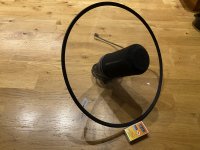Jon.Bryant
Well-known member
Probably overthinking this, but why do people favour shotguns or parabolas for NocMig recordings? Does anyone have evidence of what mics work best.
To me the problem with a shotgun, is that it effectively filters out sound off axis and this is most efficient for higher frequencies, which is generally what I want to record. As an example the Sennheiser ME66 would curtail a 4khz sound (say a Redwing) 45 degree off axis by around 2.5db (i.e. almost halving the signal strength. I don't have the ME66, but the longer shotgun (the ME 67), which is even more directional and would further curtail off axis recordings.
Parabolas I think are even worse. I remember reading that parabolas work best within a cone of 15 degrees, but some data sheets show a much narrower focus that that. Even at 15 degrees, it would mean that at an altitude of 500m you are looking at a circle of space with a diameter of only 130m Using a parabola would seem to be lowering the odds that a/ a bird will fly through this cone of space and then b/ happen to call.
Some parabola mics (i.e. the Telinga Twin Science) have two mics, one of which is cardiodal and the other omini directional. Is anyone using this type of kit and if so which mic is picking up the most sounds? - i.e. the omni with the low boost but which is less directional, or the cardiodal, which should have significant boost, but be highly directional.
I presume that if a wide Cardiodal or Omni mic is the best option for NocMig recordings, then the problem is finding a mic with good sensitivity. I imagine that wide angle mics are generally not designed with high sensitivity for picking up distant sounds.
I am going to try the Wildlife Acoustics Recorder SM4, which has reasonably sensitive Omni mics and you can add a fair amount of preamp gain. I will also attach an external mic to the recorder in a homemade parabola housing - hopefully I will get a right channel wide angle recording and a left channel boosted recording of things directly overhead. Has anyone tried the SM4 for this NocMig recordings and was it successful?
To me the problem with a shotgun, is that it effectively filters out sound off axis and this is most efficient for higher frequencies, which is generally what I want to record. As an example the Sennheiser ME66 would curtail a 4khz sound (say a Redwing) 45 degree off axis by around 2.5db (i.e. almost halving the signal strength. I don't have the ME66, but the longer shotgun (the ME 67), which is even more directional and would further curtail off axis recordings.
Parabolas I think are even worse. I remember reading that parabolas work best within a cone of 15 degrees, but some data sheets show a much narrower focus that that. Even at 15 degrees, it would mean that at an altitude of 500m you are looking at a circle of space with a diameter of only 130m Using a parabola would seem to be lowering the odds that a/ a bird will fly through this cone of space and then b/ happen to call.
Some parabola mics (i.e. the Telinga Twin Science) have two mics, one of which is cardiodal and the other omini directional. Is anyone using this type of kit and if so which mic is picking up the most sounds? - i.e. the omni with the low boost but which is less directional, or the cardiodal, which should have significant boost, but be highly directional.
I presume that if a wide Cardiodal or Omni mic is the best option for NocMig recordings, then the problem is finding a mic with good sensitivity. I imagine that wide angle mics are generally not designed with high sensitivity for picking up distant sounds.
I am going to try the Wildlife Acoustics Recorder SM4, which has reasonably sensitive Omni mics and you can add a fair amount of preamp gain. I will also attach an external mic to the recorder in a homemade parabola housing - hopefully I will get a right channel wide angle recording and a left channel boosted recording of things directly overhead. Has anyone tried the SM4 for this NocMig recordings and was it successful?






